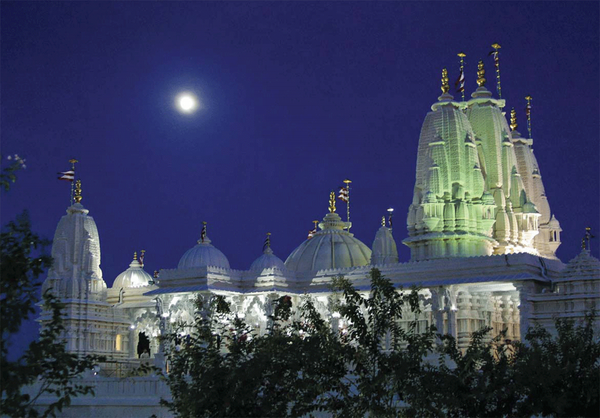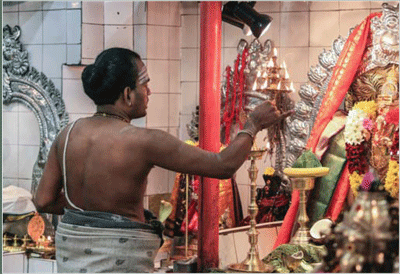Quick Start…
Dress modestly, no shorts or short skirts. Remove shoes before entering. Be respectful of God and the Gods. Bring your problems, prayers or sorrows but leave food and improper manners outside. Do not enter the shrines without invitation or sit with your feet pointing toward the Deities or another person. Refrain from gossip and worldly talk. Mute your cell phone. Treat the priests with respect and obey visitor signs. Men and women avoid hugging and other demonstrations of affection, and usually sit separately. Enjoy a spiritual time in this holy sanctuary.§
Why Are Temples Needed?
BY SATGURU BODHINATHA VEYLANSWAMI§
 few years ago at a temple in Australia, while I was chatting with sons and daughters of key members, one youth challenged: “Swamiji, since God is omnipresent, what is the need to build large temples to worship Him? The cost of construction is large, plus then you have the ongoing cost of monthly maintenance that has to be met. Couldn’t all that money be spent in a better way?” §
few years ago at a temple in Australia, while I was chatting with sons and daughters of key members, one youth challenged: “Swamiji, since God is omnipresent, what is the need to build large temples to worship Him? The cost of construction is large, plus then you have the ongoing cost of monthly maintenance that has to be met. Couldn’t all that money be spent in a better way?” §
“Good question!” I responded. “Yes, it is true that God is everywhere, permeating everything, including this room. By looking intently around us, we should be able to experience God, right? But look around you now. How many of you can see God?” They all smiled and admitted they could not. I continued: “Practically speaking, God’s omnipresence is at a very subtle level, too subtle for most of us to experience without a lot of experience in meditation.” §
That’s how I explain the need for the Hindu temple: it is a special space in which the inner and outer worlds commune and we can experience Divinity. If we want to see a distant galaxy, we can go to an observatory and look through a powerful telescope. To see into the nucleus of a cell, we go to a laboratory and use a microscope. Similarly, to know God, we can go to the temple and experience Divinity through the sanctified murti. Temples are especially sacred for three reasons: construction, consecration and continuous daily worship. §
Hereditary temple architects, known as sthapatis, are commissioned to design and construct the temple according to the sacred architecture found in the Agamic scriptures. Consecration occurs through the powerful ceremony of kumbhabhishekam, with many priests performing elaborate rituals for several days. Then begins the perpetual schedule of obligatory pujas conducted by highly trained priests. These daily pujas sustain and build on the power set in motion at the kumbhabhishekam. §

Santuaries for God: The BAPS Swaminarayana Mandir of Houston, Texas
• • • • • • • • • • • • • • • • • §
Hindu Temples Are
Not All Alike
 DEALLY, TEMPLES (OFTEN CALLED MANDIRS) are built in accordance with the ancient scriptures, planned out by skilled Indian architects to resemble the traditional styles found in India. This ideal temple has certain features: 1) a central sanctum enshrines the main Deity; 2) other Deities in the pantheon are represented by murtis in secondary sanctums or shrines; 3) the structure has no basement; 4) cultural and social activities are provided for in separate facilities, not in the main area dedicated for worship; 5) trained, ordained priests perform a daily regimen of pujas (others do not enter the shrines); 6) the temple openly represents a particular denomination of Hinduism and a specific lineage of teaching and liturgy.§
DEALLY, TEMPLES (OFTEN CALLED MANDIRS) are built in accordance with the ancient scriptures, planned out by skilled Indian architects to resemble the traditional styles found in India. This ideal temple has certain features: 1) a central sanctum enshrines the main Deity; 2) other Deities in the pantheon are represented by murtis in secondary sanctums or shrines; 3) the structure has no basement; 4) cultural and social activities are provided for in separate facilities, not in the main area dedicated for worship; 5) trained, ordained priests perform a daily regimen of pujas (others do not enter the shrines); 6) the temple openly represents a particular denomination of Hinduism and a specific lineage of teaching and liturgy.§
While these principles are well known among the thousands of communities of Hindus around the world, the reality is that each temple comes up in it own way, organically, with the above ideals flexing with the exigencies of the day, the resources and often mixed geographical background of the constituents. Hence, we now have a vast variety of temples, particularly outside India, each serving the needs of its community as a center of worship, culture, community service and spiritual fellowship.§
Every temple is unique. Agamic temples provide elaborate pujas several times per day. The main Deities are in distinct, prominent sanctums. Individuals come and go at any time and worship privately or as a family. Other temples may be structured as a simple hall with a stage in front, and Deities on pedestals usually around the perimeter of the room. The style of worship here is often congregational, with temple members gathering at a set time for a structured service conducted by a priest or elder. In some mandirs devotees may do a simple puja themselves. Services may include some form of teaching, such as a lecture by a swami or lay leader, and devotional singing or dramatic readings from the epics, Ramayana and Mahabharata. §
Here is the format followed at the Hindu temple in Midland, Texas, as described by Dr. Padmaja Patel: “Every week on Sunday we gather at our temple from 10:30 to 12:30. After removing our shoes in our shoe room, we enter the main hall. The men and women sit separately. There are a set of shlokas and stutis that everyone chants together, followed by bhajans, which are usually in the call-and-response fashion. At the end of the session, our priest will perform a short puja to a particular Deity. Then we sing a food-offering song, followed by the ‘Om Jai Jagadish Hare’ arati, where everyone can come forward. There are usually four or five arati trays with which people can offer arati to their Ishta Devata, or chosen Deity. Then we adjourn to a separate hall and enjoy the blessed food offerings as prasad.” §
Consult members of the community in advance to learn how best to prepare yourself to attend a particular temple. §

A priest holds the arati flame before Lord Ganesha at the Sri Manika Vinayakar Alayam in Paris
• • • • • • • • • • • • • • • • • §
What Is Puja All About?
 he Hindu worship service called puja, literally “adoration,” is the central activity in most temples. Conducted by a priest, or pujari, puja is similar to a grand reception for a king. The ritual can last from ten minutes to several hours. §
he Hindu worship service called puja, literally “adoration,” is the central activity in most temples. Conducted by a priest, or pujari, puja is similar to a grand reception for a king. The ritual can last from ten minutes to several hours. §
All puja follows one basic pattern. First, the pujari purifies himself, the sacred implements and the place of worship. He chants in Sanskrit the time, place and nature of this particular puja. Through hand gestures (mudras) and mantras, he beseeches the Deity to come and dwell in the image. Ringing a bell and intoning mantras and hymns from the ancient Vedas and Agamas, the pujari then offers precious substances to the Deity, including water, uncooked rice, holy ash, sandalwood paste and kumkum. Some rites include a ritual bath, called abhishekam, in which water, sesame oil, turmeric water, saffron, milk, yogurt, ghee, honey, lime juice, vibhuti, sandalwood paste, panchamritam (mixture of five fruits), coconut water and rosewater are poured over the Deity. §
Devotees are seated during most of the puja, usually on the floor. After abhishekam, the Deity is dressed in new clothes and beautifully decorated with flowers. At this point, devotees may sing devotional songs. After decorating the Deity, the pujari offers incense, oil lamps and food. He offers flowers while chanting 108 names of the God. At the high point of the puja, a large lamp is waved before the Deity and bells are rung loudly as God sends His power through the holy image of Himself. When the lamp is lowered, everyone prostrates to the Divine. The lamp is then carried out to bless the worshipers, who often leave a donation on the tray (or later in the temple offering box). Finally, depending on the tradition, sacraments such as sacred ash, blessed water, sandalwood paste, kumkum, fruit, sweets and flowers are passed out to bless all present. These include a portion of the offerings—flowers, cooked food and more—brought by devotees. Devotees may then sit in meditation, basking in the blessings invoked by the puja.§